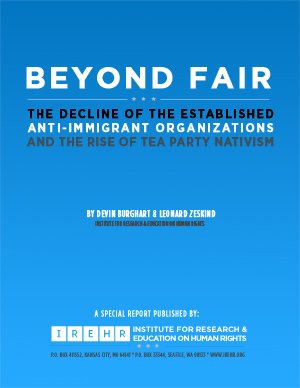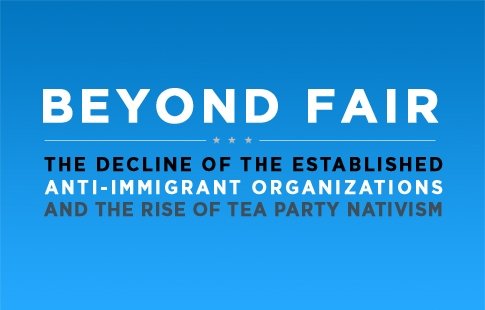In this special report the Institute for Research & Education on Human Rights (IREHR) delineates the intersection of two trends. One is a measureable drop in the number of local and national anti-immigrant organizations that were established prior to the presidency of Barack Obama. Along the same lines, those organizations which remained experienced a noticeable decrease in the size of their membership and financial support.

This has led to a relative decline in what IREHR describes as the Nativist Establishment. It should be noted that IREHR is not arguing that these organizations have disappeared altogether. Neither does IREHR contend that such organizations have ceased to be a danger to human rights. Rather, the data suggests that their size and power have fallen relative to the strength they had achieved at their height during the period 2007-2008.
The second trend is a rise in anti-immigrant activism by the Tea Parties. As IREHR reported in its 2010 special report, Tea Party Nationalism, anti-immigrant sentiment and activism have been part of the Tea Party mix from the beginning. Indeed, we noted then that one of the six national factions, 1776 Tea Party, had imported its staff leadership directly from the Minutemen. In Beyond FAIR, however, we note both an increase in anti-immigrant activism by national and local Tea Party groups, as well as a measurable number of anti-immigrant leaders who have joined the Tea Parties and consequently accelerated the rate of anti-immigrant activism by those Tea Parties.
To a noticeable degree, the transfer of organizational allegiances to the Tea Parties noted in trend two is caused by the drop in strength by established anti-immigrant organizations described in trend one.
This re-articulation of the Nativist Establishment into the Tea Parties changes both the shape and strength of the anti-immigrant impulse in American life. Mixed into the activities of multi-issue organizations (the Tea Parties), it will be harder to delineate and counter by immigrant rights advocates. Further, the Tea Party movement by itself is larger and more significant than the Nativist Establishment ever was, even at its height. As a result, anti-immigrant activism has a bigger immediate constituency and is likely to be stronger.
Among IREHR’s findings in this report:
• IREHR has identified 107 local and state leaders of anti-immigrant groups who have jumped over to the Tea Parties.
• The membership of the Federation for American Immigration Reform fell by 58% from a high in 2007 to its new low in 2011.
• The total gross receipts for ten established nativist organizations fell by 28% from 2008 to 2009.
• The number of Minuteman organizations dropped by more than half, down from 115 local chapters in 2010 to 53 local groups in 2011.
• The number of active local anti-immigrant groups fell 62%, from 320 in 2010, to 121 in 2011.
• Jim Gilchrist, founder of the Minuteman Project in California, is now a member of the 1776 Tea Party faction.
• The number of punitive bills aimed at immigrants that have been introduced in the states has continued to skyrocket, however. Opinion polls show nativist sentiment at dangerously high levels, as the Tea Party has become a new force driving anti-immigrant politics.






